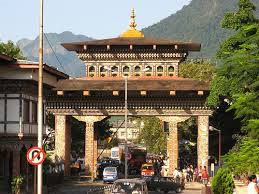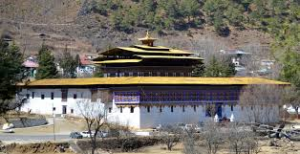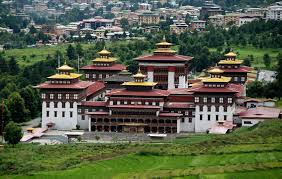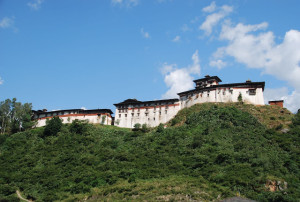PHUENTSHOLING
Phuentsholing was the gateway of Bhutan when air travel was not introduced to Bhutan. It is a historic trading post and many British missions came to Bhutan from British India in the late 1700s through this area. Located adjacent to the Indian plains it harbours a sub-tropical climate and vegetation. It is the frontier and thriving commercial trading center bordering the Indian state of West Bengal. It is located to the south of Thimphu, the capital, and Paro International Airport; it takes approximately about 5 hours by car to reach Phuentsholing from Paro and Thimphu. Phuentsholing is your entry point into Bhutan if you are coming by road from Sikkim, Darjeeling and Bagdogra airport in India. It takes between 3-5 hours of driving from the places mentioned above.
While in Phuentsholing you can visit the ZangdoPelri temple (representation of the abode of Guru Rinpoche) in the center of town. You can also enjoy a bird’s eye view of the plains from scenic Kharbandi Gompa.
PARO
(Altitude 8500 feet)
Generally, visitors entering Bhutan by air on the national airline, Druk Air, will land at Paro, situated at an elevation of about 8000 feet above sea level. A living cultural center, the Paro valley is adorned with magnificent sights of some of Bhutans oldest temples & monasteries.
Depending on the season the valley floor is covered with green yellow or brown fields, while small hamlets and isolated farms dot the landscape. The valley is also known for its red rice, apples and fruits. The Paro festival (Paro Tshechu) is a famous event every year and draws thousands of
visitors from around the world.
Some of the places you can visit while in Paro are Drugyel Dzong, Rinpung Dzong, Ta Dzong, Kyichu Lhakhang and Taktsang Monastery.
HAA
The Haa valley was opened for the first time to foreign tourism in 2002. Haa, the abode of the local deity Ap Chhundhu is a high altitude valley. This is the western-most district of Bhutan and borders Sikkim state on the west. There are old trade routes going from Haa to Sikkim and
Tibet.
To the north-west is the Tibetan Autonomous Region of China. To the south it is bounded by Samtse Dzongkhag (district), to the south-east by Chukha, and to the east by Paro Dzongkhag. Haa is a culturally rich valley and some of the famous sites in Haa are the Lhakhang Nap (Black),
Lhakhang Karp (White), and Haa Gonpa.
Beside the above sites, the valley itself is dotted with pretty villages and the rich architectural works can be seen on every house. There are day hikes starting from Haa that will take you to Paro through lush coniferous forests. Chelela pass between Haa and Paro is a popular spot for finding the rare Blue Poppy, the national flower of Bhutan.
THIMPHU
(Altitude 8500)
About 53 Km from Paro airport is Thimphu, the capital of Bhutan. The centre of government administration, religion & commerce, Thimphu is a unique city, with an unusual mixture of modern development alongside ancient tradition. Home to civil servants, expatriates and the monk body, Thimphu maintains a strong national character in its architectural style. The Thinchu river cuts through the narrow valley.
Major places of interest in Thimphu are the Memorial Chorten, Tashichhodzong, Simtokha Dzong, National Library, Zorig Chusum Institute, Folk Heritage Museum, Textile Museum with Day hikes to Phajoding Goenpa, Tango and Cheri Monastery. At the National Library, you can glimpse the largest book in the world entitled Bhutan by Michael Hawley from MIT.
PUNAKHA
Two and a half hours drive from Thimphu is the old capital of Bhutan, Punakha. Pine trees line the journey out of Thimphu to this old capital with a climb to Dochula pass (10,500 ft) giving travelers a spectacular view of the mighty Himalayan mountains towards the north. On the descent
you enter lush rhododendron and cool broadleaved forests. In Spring the rhododendrons are in bloom and the whole mountainside is decked in white, pink, yellow and red blossoms. The dangling lichens are indication of the clean unpolluted mountain air.
Located at an altitude of 4430 feet above sea level, Pungthang Dechen Phodrang Palace of Great Happiness, popularly known as Punakha Dzong was built in 1637 by Zhabdrung Ngawang Namgyal. It is the winter residence of Bhutans spiritual leader Je Khenpo and the monks of the Central Monastic Body. The majestic fortress sits on a spit of land between the male and female rivers (Pho Chu and Mo Chu). It was here on 17th December 1907 that Bhutan’s first king, Ugyen Wangchuck, was crowned. It is also the venue for the Punakha Dromchoe festival held in February or March each year.
About 12 Km away from Punakha, towards Wangduephodrang is another historical monument Chimi Lhakhang dedicated to the Divine Madman Drukpa Kuenley. There are various places for day hike, bird watching and trekking in Punakha.
WANGDIPHODRANG
The last town on the lateral highway before entering Central Bhutan has the beautiful Wangdue Phodrang Dzong built by Zhabdrung Ngawang Namgyal in 1638. It sits on a hilltop overlooking the two rivers Punatsang Chu and Dang Chu. This Dzong played a critical role in the 17th century in unifying the districts of western, central and southern Bhutan. Located at the same elevation as Punakha, it’s about 30 minutes drive from Punakha. The Wangdue festival is celebrated here in the fall.Rinchengang, a densely clustered village sprawling on the slope facing the Wangdue Dzong, is known for its skilled stone masons. It is a short 20 minutes hike uphill to the village and offers a great view of the Dzong, the valley and the river.














